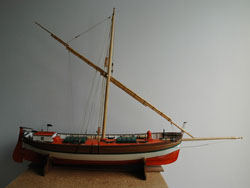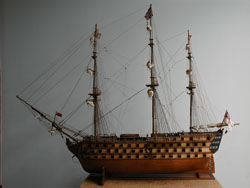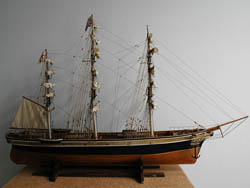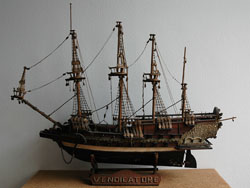
|
| Leudo |

|
| Victory |

|
| Cuttysark |

|
| Caravella |

|
| Vendicatore |
Maritime Art
wikipedia.it
Naval modeling as artigianal activity was born in the ancient Roma, to represent a quicker transportation of death people to the afterworld. Into mediterranean civilizations wasn't rare that naval models were present into grave goods of high rank people. Usually they were made by resistent materials that could resit for centuries and reporting us the ancient origin of this wonderful art.
Ancient ship and boat models have been discovered throughout the Mediterranean, especially from ancient Greece, Egypt, and Phoenicia. These models provide archaeologists with valuable information regarding seafaring technology and the sociological and economic importance of seafaring. In spite of how helpful ancient boat and ship models are to archaeologists, they are not always easily or correctly interpreted due to artists’ mistakes, ambiguity in the model design, and wear and tear over the centuries. In the Ancient world, ships “were among the most technologically complex mechanisms of the ancient world.” Ships made far-flung travel and trade more comfortable and economical, and they added a whole new facet to warfare. Thus, ships carried a great deal of significance to the people of the ancient world, and this is expressed partly through the creation of boat and ship models. Ancient boat and ship models are made of a variety of materials and are intended for different purposes. The most common purposes for boat and ship models include burial votives, house hold articles, art, and toys. While archaeologists have found ship and boat models from societies all around the Mediterranean, the three of the most prolific ship model building cultures were the Greeks, Phoenicians, and Egyptians. Archaeologists have determined that Ancient Greek ship models were used as burial or votive offerings and as household articles such as lamps or drinking vessels. The kinds of ships depicted in Ancient Greek models can be classified broadly as small craft, merchant vessels, and warships. Models were cast in different materials, including wood, bronze, lead, and clay. Greek warships were popular subjects to be made in miniature. One particular model, acquired by the Staatliches Museum (engl.: Land museum) in Kassel, Germany, proves to be helpful to archaeologists and historians in understanding what a hemiolia warship was like. Archaeologists have tentatively dated the Kassel model to be from the 6th or 5th centuries BC through iconographic and literary sources. This ship model is made of clay and features a distinctive prow shaped like a boar’s head that is described by Herodotus in The History, and depicted on pottery, coins seals and drinking cups. The model is a miniature of a vessel that would have been too small to be a typical warship. The presence of holes bored into 8 thwarts in the ship suggests that the thwarts may have been seats for a pegged-in dummy crew. If the holes bored into the thwarts are indeed meant to accommodate a dummy crew, the crew seating would have been arranged with two men per bench amidships, and one man per bench fore and aft where the ship narrows so that there is only room for one man. Alec Tilley (former Royal Navy and Navy of Oman officer) suggests that a small ship with this type of seating arrangement would have been called a hemiolia, or a one-and-a-halfer. The name indicates that two oarsmen would have been seated on half of the benches and one on the others. Until this ship model was discovered, archaeologists, classicists, and historians had only been able to hypothesize on what the seating arrangement might have been like on a hemiolia based on its name. Not all ancient Greek ship models are of warships. One boat model from a house deposit in Mochlos, Crete, dating to around 3000BC, is thought to be too small to be a war ship. Belgian maritime historian L.Basch postulates that the boat “cannot have been propelled by more than four oarsmen … so it can hardly be other than a fishing boat.” As opposed to other Early Bronze Age ship and boat models, this model was not found in a burial context. This model is thought to be a child’s toy or a piece of art, instead of a burial offering. The model itself features a projection of the keel beyond the stem-post at both ends. Despite appearances, these projections are not rams. Because the model is depicting a fishing boat, there would be no need for rams. This model in particular has helped archaeologists understand that not all keel projections in depictions of boats during this time are necessarily rams. Instead, keel projections on depictions of Bronze Age ships are explained as cut-waters or as beaching protection. Phoenician ship models also provide archaeologists information regarding the technical aspects of seafaring, and the cultural importance of seafaring for the ancient Phoenicians. However, some models offer tantalizing pieces of information that are, however, difficult to interpret. Item number H-3134 at the Hecht Museum, a dark-brown clay model of a 5th-century BCE oared boat, is one such craft. The vessel has no provenance, save for the reported location of its discovery off the Phoenician coast, but scientists have been able to tentatively confirm the origin and authenticity of this model. The model is of an oared boat manned by three pairs of oarsmen, who are rendered with “hands … raised to their chests, in the last instant of pulling the oar in the water, before lifting it for the recovery.” The mystery of this model is the purpose of small holes- three on the starboard side, and four on port- that were made in the sides of the ship with a sharp tool before the clay dried. It is believed that the holes are too small to pass an oar through, and thus would not be used for rowing purposes. This is hard to prove, however, because the poorly preserved state of the model and the amount of fouling that is layered on the model makes it difficult to definitively rule out this possibility. Another theory regarding the purpose of these holes suggests that “ropes for holding oars were threaded through these holes.” Ship models are helpful to archaeologists in that they allow archaeologists to make estimates regarding the size the vessel would be in real life. While this technique makes the assumption that artists scaled the models appropriately, it is useful to get some sense of how large these ships and boats may have been in real life. Archaeologists estimate the Phoenician vessel above (H-3134) to be about 6 meters long and the beam about 2 meters. Archaeologists are able to calculate these estimates of size by employing a series of assumptions about the distance between benches, the lateral distance between rowers, and a maximum draft of the vessel. Egyptian ship and boat models are perhaps some of the most enchanting and well-preserved types of ship models available to archaeologists. Some small models made from ivory, wood, or clay exist, and archaeologists believe these models were actually children’s toys. This is fairly rare, however, because ancient Egyptian ship and boat models more often were placed in tombs of prominent people as “magical substitutes for the actual objects which the deceased has used in life and which he expected to use again in the next world.” Boats placed in tombs of Egyptian royalty can be separated into two types: boat models that represent actual vessels used on the Nile, and boat models that represent boats that are considered necessary for religious purposes. The second type of model may or may not have been used in real life, but were purely magical boats. The majority of boats found in tombs are carved from wood. Several boat and ship models were found in the tomb of Tutankhamen, dating back to the Sixth Dynasty, and in the tomb of Meketre (2061-2010 BC). The wide variety of vessels depicted by the models in these two tombs has provided archaeologists new information on the types of boats that were used in Egypt. Moreover, the presence of boat and ship models in the tombs attests to the paramount importance of boats and ships to the Nile-going people of Egypt. The boat models discovered at Meketre′s tomb feature several different kinds of boats, including traveling boats, sporting boats, and several papyriform crafts. Two of the papyriform skiffs have a trawling net slung between them. It is uncertain whether or not the net is meant to be depicted as being under the water or being pulled out of the water by the fishermen. In the event that the artist meant for the net to be in the water, it is interesting to note that the net is upside down. Needless to say, the upside down net would not work for catching fish. This ambiguity points up the question of artistic veracity of the craftsmen who make ship models. As is attested by the ambiguity of the holes in the sides of the Phoenician model, and the skiff from Meketre, archaeologists need to be aware of the possibility of artistic error while interpreting ancient ship models. While a mistake involving an inverted trawling net may seem trivial, the lesson is important. It is important for archaeologists to be aware of the possibility that ancient artists may not have been familiar with the finer details of ships and boats. Despite some of the limitations of interpreting ancient Mediterranean ship models, archaeologists have been able to glean a great deal of information from these items. This information has been instrumental in filling in gaps in knowledge about ancient seafaring technology and culture.



